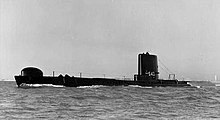 HMS Amphion (P439) HMS Amphion (P439)
| |
| History | |
|---|---|
| Ordered | Very late in World War II |
| Builder | Vickers Armstrong, Barrow-in-Furness |
| Laid down | 14 November 1943 |
| Launched | 31 August 1944 |
| Commissioned | 27 March 1945 |
| Identification | Pennant number P439 |
| Fate | Sold to be broken up for scrap on 24 June 1971. Scrapped at Inverkeithing in July 1971. |
| Badge |  |
| General characteristics | |
| Class and type | Amphion class |
| Type | submarine |
| Displacement | 1,360/1,590 tons (surface/submerged) |
| Length | 293 ft 6 in (89.46 m) |
| Beam | 22 ft 4 in (6.81 m) |
| Draught | 18 ft 1 in (5.51 m) |
| Propulsion | 2 × 2,150 hp Admiralty ML 8-cylinder diesel engine, 2 × 625 hp electric motors for submergence driving two shafts |
| Speed | 18.5 kn (34.3 km/h) surface, 8 kn (15 km/h) submerged |
| Range |
|
| Test depth | 350 ft (110 m) |
| Complement | 60 |
| Armament |
|

HMS Amphion (P439), was an Amphion-class submarine of the Royal Navy, built by Vickers Armstrong and launched 31 August 1944.
HMS Amphion, later S43, was the first of the class to be launched in August 1944. She was originally to be named as HMS Anchorite but their names were exchanged before launch. Of the class, only Amphion and HMS Astute were completed before the end of the war, and neither were involved in hostilities. In 1953 she took part in the Fleet Review to celebrate the Coronation of Queen Elizabeth II.
Design
Like all Amphion-class submarines, Amphion had a displacement of 1,360 tonnes (1,500 short tons) when at the surface and 1,590 tonnes (1,750 short tons) while submerged. It had a total length of 293 feet 6 inches (89.46 m), a beam of 22 feet 4 inches (6.81 m), and a draught of 18 feet 1 inch (5.51 m). The submarine was powered by two Admiralty ML eight-cylinder diesel engines generating a power of 2,150 horsepower (1,600 kW) each. It also contained four electric motors each producing 625 horsepower (466 kW) that drove two shafts. It could carry a maximum of 219 tonnes (241 short tons) of diesel, although it usually carried between 159 and 165 tonnes (175 and 182 short tons).
The submarine had a maximum surface speed of 18.5 knots (34.3 km/h; 21.3 mph) and a submerged speed of 8 knots (15 km/h; 9.2 mph). When submerged, it could operate at 3 knots (5.6 km/h; 3.5 mph) for 90 nautical miles (170 km; 100 mi) or at 8 knots (15 km/h; 9.2 mph) for 16 nautical miles (30 km; 18 mi). When surfaced, it was able to travel 15,200 nautical miles (28,200 km; 17,500 mi) at 10 knots (19 km/h; 12 mph) or 10,500 nautical miles (19,400 km; 12,100 mi) at 11 knots (20 km/h; 13 mph). Amphion was fitted with ten 21 inches (530 mm) torpedo tubes, one QF 4 inch naval gun Mk XXIII, one Oerlikon 20 mm cannon, and a .303 British Vickers machine gun. Its torpedo tubes were fitted to the bow and stern, and it could carry twenty torpedoes. Its complement was sixty-one crew members.
References
- "HMS Amphion (P 439) of the Royal Navy - British Submarine of the A class - Allied Warships of WWII - uboat.net". www.uboat.net. Retrieved 15 April 2021.
- Colledge & Warlow 2006, p. 30.
- Souvenir Programme, Coronation Review of the Fleet, Spithead, 15 June 1953, HMSO, Gale and Polden
- ^ Paul Akermann (1 November 2002). Encyclopedia of British Submarines 1901–1955. Periscope Publishing Ltd. p. 422. ISBN 978-1-904381-05-1.
- "Acheron class". World Naval Ships, Cranston Fine Arts. Retrieved 20 August 2015.
Publications
- Colledge, J. J.; Warlow, Ben (2006) . Ships of the Royal Navy: The Complete Record of all Fighting Ships of the Royal Navy (Rev. ed.). London: Chatham Publishing. ISBN 978-1-86176-281-8.
External links
| Amphion-class submarines | |
|---|---|
| Completed | |
| Cancelled | |
| |
| Shipwrecks and maritime incidents in 1967 | |
|---|---|
| Shipwrecks |
|
| Other incidents |
|
| 1966 | |